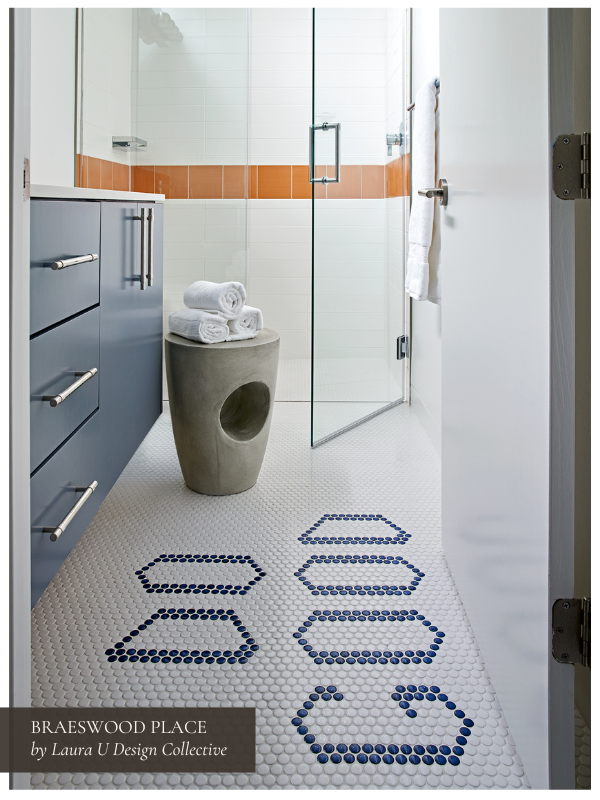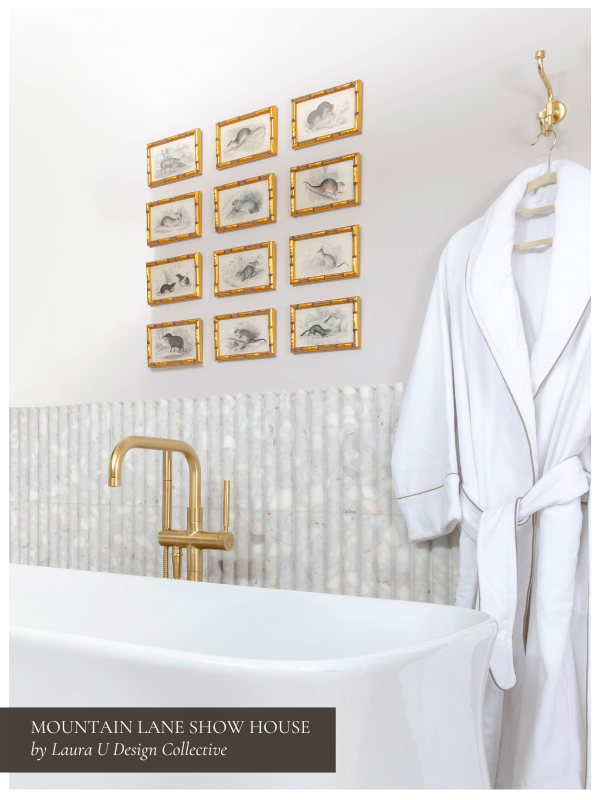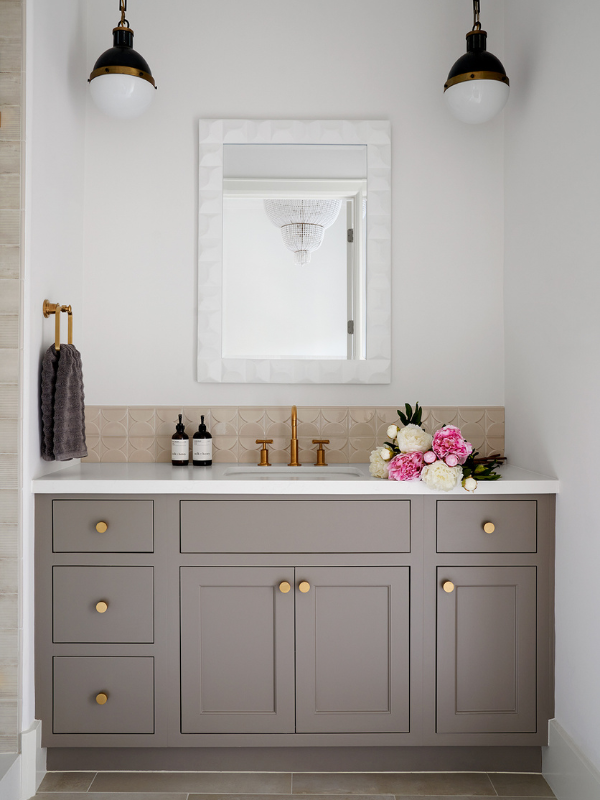At Laura U Design Collective, we believe every design decision—right down to the smallest tile—should elevate how you live and feel in your home. And while many trends come and go, the best ones introduce new ways to add texture, personality, and architectural depth. In 2025, we’re seeing tile be bolder, bigger, and more beautifully unexpected. This year’s trends help designers and homeowners alike create a more layered, luxurious foundation for everyday life. From color drenching to fluted details, read on for the latest tile trends in bathrooms, kitchens, and fireplace surrounds.
2025 Trends in Tile & What We Think Will Stand the Test of Time
#1 Color Drenching from Floor to Ceiling
Color drenching isn’t new, but in 2025, it’s being taken to exciting new heights with a surprising material: tile. Designers are moving far beyond white walls and safe backsplashes, instead leaning into deeply saturated spaces where one hue coats everything from walls to floors to trim.
This results in immersive and intentional spaces that feel unique and elevated even when the hue is a pastel rather than a bold color. These are not the color-drenched spaces of yore but rather a modern nod to monochrome that doesn’t feel flat. In some cases, designers are embracing “double drenching,” which refers to layering two rich tones like emerald and rose quartz or navy and terracotta across tile surfaces to create more dynamism.
According to Fireclay Tile, this look creates “a cohesive and sophisticated environment” and allows architectural details to truly have their moment. When done with tile, especially in matte or handmade finishes, the effect is grounded, bespoke, and surprisingly timeless.
#2 Mosaic Floors and Backsplashes (Braeswood Place powder)

Later on in this post, you’ll find that large format tiles are a popular choice among high-end designers, but tiny tiles are also having a major moment. Whether geometric, floral, or freeform, mosaic patterns are showing up everywhere from bathroom floors to kitchen backsplashes.
As shown above in our Braeswood Place pool house bath, these designs are a great way to personalize a space, but they also tap into centuries of tile history, which makes them feel uniquely trend-forward and timeless. Whether you’re using simple black-and-white hexes or vibrant glazed squares, mosaic tile is a go-to for maximalists and minimalists alike.
#3 Elevated Textures Like Fluting and Handmade Finishes

Many designers are dialing up tactile appeal in 2025, selecting fluted ceramic backsplashes, zellige walls, and handmade tiles that capture light organically. This rise in texture makes even a neutral space with natural materials feel layered and dynamic. You don’t need jewel tones, intense color palettes, or a crazy tile installation to make a space seem special.
Petra McKenzie told Martha Stewart Living that “textural patterns are huge,” whether they’re built into the tile itself or created by combining different shapes and finishes. The effect designers achieve in doing so is subtle, sculptural, and deeply luxurious.
Natural glazes and warm neutrals, in particular, give a space enduring appeal without overpowering it.
#4 Traditional Shapes Reimagined
Timeless shapes like squares, diamonds, and checkers are making a strong comeback, but not in the ways you might expect. In 2025, designers are rotating squares into diamonds, layering checkerboard patterns in surprising tones, and bringing back wainscoting-style tile walls with colorful trims.
As Fireclay Tile notes, this return to traditional silhouettes often includes modern twists: classic patterns “layered with unexpected textures and decorative trim.” In the end, each space nods to the past while feeling fresh and deeply personal.
#5 Vertical Stacks
Forget horizontal subway tile (at least for a little while); vertical stacking is dominating powder bath interior design this year. Unlike other installation options, this layout elongates walls, adds visual interest, and makes smaller spaces feel taller.
Whether it’s slim rectangular tiles or elongated bricks, stacking them upright creates a clean, modern, and architectural effect. Consider the bath pictured above, with two tones of vertically stacked Ann Sacks tile: teal and white.

#6 Material Drenching
Material drenching either involves using the same tile on both floors and walls to create a seamless, wraparound effect or multiple tiles throughout the same space without the use of wallpaper, other flooring materials, etc. Many designers are embracing the former version of this trend (pictured below) in both bathrooms and powder rooms because consistent texture and tone enhance the overall atmosphere in those spaces.
As Danielle Chiprut told House Beautiful, this method “provides continuity, making even small spaces feel larger and more intentional.” Applied with ceramic tiles or natural materials like limestone and travertine, material drenching adds organic feel and enduring appeal to any project.
While it might remind you of your local YMCA locker room in theory, floor to ceiling tile can indeed be elevated and sophisticated in practice. Above, a bathroom boasts multiple types of tile in a single room; how’s that for material drenching?
#7 Large-Scale Tile and Slab Formats
In both bathrooms and kitchens, large-scale slabs are having a moment. These oversized ceramic and porcelain pieces reduce grout lines to create sleek, seamless surfaces with minimal interruptions. They are perfect for floors and walls in bathrooms, kitchens, or any room that needs a clean, contemporary edge.
According to Michelle Murphy in House Beautiful, large-scale slabs “create a seamless and luxurious look,” while also being quite low-maintenance. However, you don’t need a single slab to make an impact. Whether you wish to replicate the look of marble, stone, or travertine slabs, a large format tile installation can help you achieve that polished look without a single (expensive and fragile) slab.
Slabs of natural materials will always be timeless, in our opinion!
#8 Architectural Detailing
Tile isn’t just for surfaces anymore, though it can be used to reinforce architectural elements like arches and portals. From cornices and moldings to tiled wall frames and chair rails, tile is now being used to define rooms with added texture and shape.
Nowhere achieves this quite like Seattle’s U.S. Bank Center, which is awash with gorgeous green tiles that line it’s edges, columns, pillars, and other architectural details. It is so unexpected yet incredibly beautiful. Cheers to our friends at Ann Sacks!
#9 Tiled Furniture (Both DIY and Designer)
Tiling isn’t limited to the floors or walls anymore; it has made its way to furniture. Designers are using tile to clad waterfall islands, range hoods, and built-in benches, while DIYers are getting creative with tiled tables and planters. This is one of the more playful tile trends because it invites experimentation with texture, pattern, and installation options.
Regan Billingsley noted in Martha Stewartthat tiled furnishings “add texture and depth.” They offer the chance to explore modern applications in unexpected areas. This trend empowers homeowners to incorporate their favorite tile into nearly any surface. We’re not entirely sure if this trend is timeless, but it sure is fun!
#10 “Superfakes” that Make More Affordable Tile Look Luxury
Porcelain tiles are now mimicking marble, wood, and limestone with stunning realism and smaller costs. These tiles convincingly mimic the appearance of high-end natural materials without the upkeep or expense.
Especially in high-traffic spaces that are repeatedly exposed to the elements, “superfakes” can be a practical, beautiful option for designers and homeowners alike. They are ideal for shower walls, bathroom floors, backsplashes, and beyond because they capture the luxe look of rare materials without sacrificing durability and versatility that modern life demands.
Let Laura U Design Collective Select the Ideal Tile for Your Space

Many of the ideas outlined above (like architectural tile detailing or porcelain that mimics natural stone) bridge the gap between innovation and longevity. Of course, impactful interior design doesn’t simply follow trends; it creates spaces that feels both personal and enduring. To find the right tile for your bath, kitchen, or fireplace surround, reach out to the team at LUDC.



